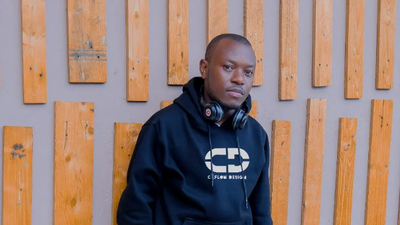How This Kenyan Designer is Using Solar-Powered Tech to Charge Up his Hoodie Game
Caflon Ruuj is making light out of a dark situation, and mixing engineering know-how with his love of designing clothing.
Caflon Ruuj knows what it means to live your dreams. Ruuj, as he’s popularly known by his friends, is the founder of Caflon Designs, a fashion brand that very literally came to him while he was sleeping. The Malawian-born designer, who lives in Nairobi’s Eastlands region, is using that dream to make hoodies that not only look good, but produce their own light and charge cellphones, too.
“The first time I dreamt I didn’t take it seriously because I thought it was a normal dream,” Ruuj tells OkayAfrica. “Then it repeated, like, three times.” He decided it was too much to ignore, even though those around him were skeptical. “I tried telling my cousins and my friends but they laughed at me; they thought this cannot happen. They kept on asking me how it was possible.”
At the time, in 2018, Ruuj was enrolled at University of Nairobi, pursuing an electric engineering course, where there were rampant blackouts on campus. They continued for some time, hampering his ability to do his assignments, and one evening, when he went to bed, an idea that would help him weather the lack of electricity came to Ruuj in a dream. “Due to blackouts and the dream, I decided to make something that would enable me to study well when there is no light,” he says. “That is how the LED hoodies were born. In fact, I appreciate it because if it wasn’t for the blackouts I wouldn’t have come up with this kind of an idea.”
Through Caflon Designs, he creates hoodies that use solar power to become their own source of energy. A power system is attached to the inside of the hoodie, and then covered with an easy-to-remove seal. This is connected with a phone charging cable. The hoodie takes 3 hours to charge, when there is a full solar source, and 5 hours during a cloudy day. After that, it works pretty much like a normal charger.
But Ruuj's first designs didn’t always rely on solar power. His initial attempts were not without their errors, but with time, he improved on his design. In the beginning, his friends would ask how one could clean the hoodie without being electrocuted. It dawned on him that in the dream he wasn’t shown how to clean it. Ruuj had to rethink everything, and eventually came up with a new idea to make the hoodies run on solar power instead of electricity.
When he first came up with the idea, he had no intention of selling the hoodies. But soon, others wanted in, too. His first client was renowned Kenyan musician Kaligraphy Jones. He saw a post that Ruuj had made on his Facebook page and decided to contact him. In 2019, the young entrepreneur decided to launch his fashion line. So far, he has sold over twenty pieces. However, he says that Kenyans have yet to embrace the idea. His own parents don't believe in it either. They've been urging him to concentrate on his studies and to stop wasting time, something that hurts Ruuj, who believes he could go further with their support.
He has had signs that he's onto something though. "I made a deal with Safaricom, Kenya’s biggest teleco to supply them with 213 hoodies for their BLAZE program, which supports youth [up] to the age of 35,” he says. But he needs capital to get these kinds of deals off the ground -- one of the biggest challenges Ruuj faces. "No one help[s] me with that kind of information. My friends also don’t know anything," he says. "My fashion line is one of a kind in the whole world. I have never heard of someone making hoodies that can charge the phone, produce light and regulate temperature."
He designs his clothes from scratch, sourcing the materials locally – at Maziwa Market along Jogoo Road in Nairobi. Ruuj works with a local tailor, too, who is Burundian. “I take the materials and the design to him. He cuts, and then he makes the hoodies for me. I start from the measurements and the sketches. The tailor’s work is to sew it. Nothing else. I also give him instructions on what he should and shouldn’t do until the cloth is complete. The tailor cannot fix the plastics and wires. So that is my work as a designer. After designing the clothes, I fix the gadgets myself," he says.
Currently, Ruuj's hoodies range from $25 to $60, depending on the design and the purpose. He's targeting a larger population across the country and internationally to help people especially in rural areas without electricity connection. “The hoodie is nice [for] motorbike riders, women who sell vegetables, security guards and all those people who wake up early in the morning," he says. He adds, the hoodie can even be hung in the house "when there is no power and it will light the house."
For Ruuj, making his dream become a reality has been hard work, but he's keeping his eyes set on the light at the end of the tunnel. "I really want my designs to become a global product. That is what I am hoping for."
- Is the African Fashion Industry Ready for the Metaverse? - OkayAfrica ›
- Here Are 5 Places Where You Can Buy African Fashion Online ... ›
- Meet the Senegalese Designer Making Math Chic - OkayAfrica ›
- Nigeria Suffers Widespread Blackouts Following Total Power System Collapse - Okayplayer ›
